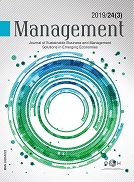Consumers’ Perception of CSR Activities: What Does it Mean for Companies?
DOI:
https://doi.org/10.7595/management.fon.2021.0017Keywords:
corporate social responsibility, conceptual model, consumer awareness, WOM, WTPAbstract
Research Question: The paper develops a conceptual model for exploring the factors which impact the consumers' word of mouth (WOM) and willingness to pay (WTP) for products and services of socially responsible companies. Motivation: The paper is based on the research of Castaldo et al. (2009), Pivato et al. (2007), Rim and Kim (2016), and Jarvis et al. (2017) concerning the consumers’ perception of corporate social responsibility (CSR) and measurement of the effectiveness of CSR activities. Accordingly, our paper tries to provide companies with valuable information on how the consumers’ perception of CSR activities impacts the consumers’ trust, awareness, purchase intention, and future behaviour. Idea: The proposed model is based on three pillars: Perception of CSR, Moderating effects, and Willingness to pay and recommend and strives to shed light on their mutual relations. The goal is to better understand the complex mechanisms and consequences of the consumers’ perception of CSR activities of companies. Data: To verify the proposed conceptual model, a questionnaire was developed and distributed. In total, 265 respondents participated in the research. Tools: Structural equation modelling (SEM) analysis was employed to explore the relationships between defined factors. Findings: The findings illustrate that both attitudes towards CSR and CSR companies have an impact on the level of trust and purchase intention. When it comes to WTP and WOM, only the level of trust and purchase intention have an impact. Interestingly, the respondents' awareness of the companies’ CSR activities did not have an impact on WTP and WOM. The model indicates that the companies should communicate their CSR activities which will lead to greater trust and purchase intention leading to higher consumers' willingness to pay and recommend the companies’ products/services. Contribution: The study empirically explores how the perception of CSR and CSR activities potentially influences the WOM and WTP on products and services of socially responsible companies and provides a roadmap on how companies can increase the benefits of their CSR activities.








